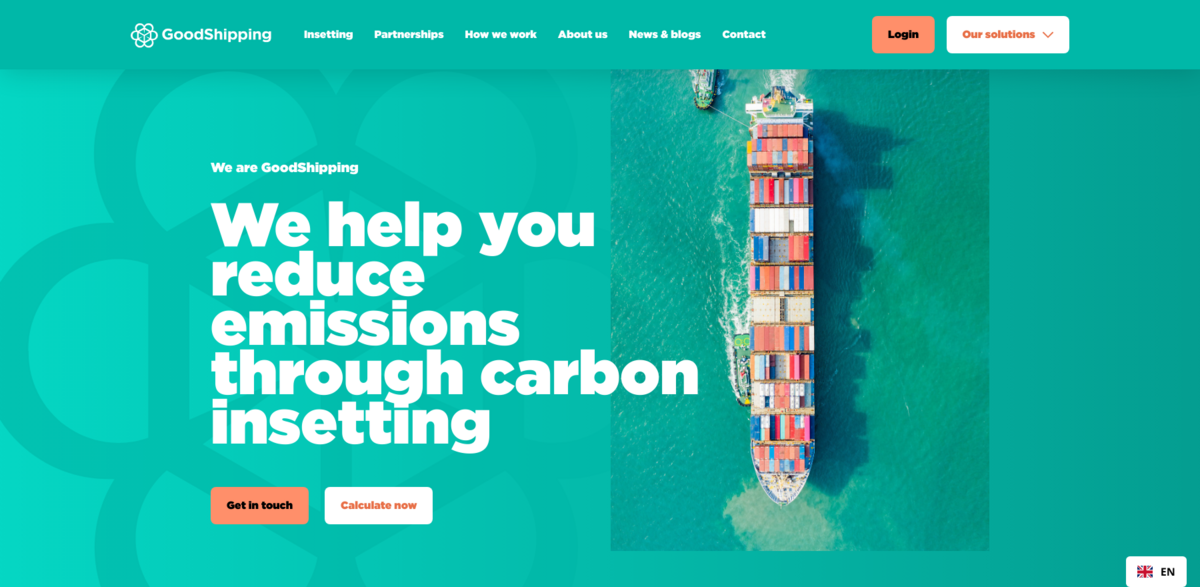What is the GoodShipping Project?
GoodShipping is a pioneering leader in carbon insetting that has been transforming the shipping industry since 2017. The initiative helps reduce emissions through carbon insetting, empowering cargo owners and freight forwarders to significantly cut down on their scope 3 CO2e emissions. The global logistics and transportation industry is responsible for over a third of worldwide CO2e emissions, making it a major contributor to pollution in many developed countries. By focusing on switching from fossil fuels to sustainable biofuels made from waste streams, GoodShipping has created a simple yet effective way to decarbonize supply chains. The approach is straightforward… and impactful, offering a real solution to a pressing environmental challenge.
Main Benefit
- Reduces over a third of global shipping emissions.
- Enables a flawless fuel switch through a Book & Claim principle.
- Calculates CO2e emissions with precision before making changes.
- Issues secured certification based on independent audits.
- Offers a hassle-free, immediate pathway to lowering emissions.
The Insetting Approach Explained
The core idea behind insetting is as practical as it is innovative. The process begins with calculating the CO2e emissions of shipping operations. Next, using available budgets and sustainable ambitions, the necessary emission reductions are determined. A fuel switch is then facilitated; this involves replacing fossil fuels with sustainable biofuels in carriers that would have otherwise consumed conventional fuels. The biofuels used are low-carbon alternatives that, when applied, effectively reduce overall shipping emissions. The result is a direct impact: every shipment powered by these renewable biofuels contributes to controlling global climate change. It’s a clever, efficient system that offers both simplicity and reliability… a system that makes a measurable difference.
How the Process Unfolds
The entire emission reduction process is built around three simple steps. First, the CO2e emissions from shipping are calculated meticulously, ensuring that the numbers truly reflect the environmental challenge at hand. Once the emissions are known, a fuel switch is performed with precision—sustainable biofuels replace the fossil fuels that would have been used, thanks to the Book & Claim principle. Finally, an official CO2e reduction certificate is provided, detailing the exact impact of the fuel switch. This certificate is based on industry standards and is independently verified, giving stakeholders confidence that their transition to sustainable shipping is both genuine and compliant. The whole process is designed to be as straightforward as possible, minimizing disruption while maximizing environmental benefits.
Why the Switch is a Game Changer
There are three key reasons why shifting to carbon insetting is a game changer for the shipping industry. First, insetting creates an actual reduction in carbon emissions today, providing an immediate response to the challenge of climate change. Second, making the switch requires no disruptive changes to existing supply chain logistics; the process runs seamlessly in the background while delivering measurable environmental benefits. And third, this approach is fully compliant with future regulatory requirements, preparing the industry for upcoming sustainability mandates. This trifecta of benefits—immediate action, ease of attainment, and regulatory compliance—makes the switch not just a smart move, but a necessary evolution for an industry so central to global commerce.
The Wider Context and Industry Relevance
The shipping industry’s reliance on fossil fuels has long been a critical concern. Today, as the need for sustainable change becomes more urgent, the approach taken by GoodShipping stands out. By embracing carbon insetting, the project redefines what is possible in the realm of sustainable transport. The initiative does not simply offset emissions; it actually reduces them by replacing high-carbon energy sources with renewable biofuels. This method proves that sustainable practices can be integrated into large-scale operations without sacrificing efficiency or reliability. The process is practical, transparent, and innovative, ensuring that every step in the carbon insetting journey is clearly documented and verified. It’s a reminder that even industries steeped in tradition can find new life through methods that prioritize both profit and planet.
Project Impact
- SDG 7: Affordable and Clean Energy – by promoting sustainable biofuels.
- SDG 9: Industry, Innovation, and Infrastructure – through pioneering carbon insetting.
- SDG 11: Sustainable Cities and Communities – by reducing urban pollution from shipping.
- SDG 12: Responsible Consumption and Production – with a focus on renewable resources.
- SDG 13: Climate Action – by significantly curtailing CO2e emissions across the transport sector.
Sustainable Ocean Freight and the Road Ahead
GoodShipping’s model extends beyond road freight—it is equally transformative in making ocean freight sustainable. The innovative strategy focuses on reducing carbon emissions by switching to renewable biofuels that are produced responsibly from waste streams. This approach not only cuts down on CO2e emissions but also acts as a beacon for the future of global logistics, where sustainability and compliance are key. Stakeholders and industry observers will find that the transparent tracking and verification methods, based on the Book & Claim chain of custody model, lend extra credibility to the entire process. A future where ocean freight contributes to environmental sustainability is not only possible—it is already underway, paving the road ahead for an industry ready to embrace change… and drive it forward.





















